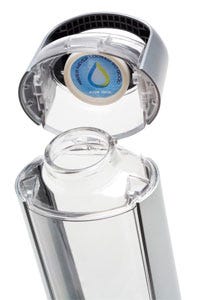In an effort to provide attention-grabbing water hydration solutions, KOR Water has partnered with design firm RKS, plastics supplier Eastman Chemical Co. and injection molder Nypro to reach its goal of creating a high-quality water bottle that promotes reusability through a sleek and innovative design. The design called for a container that was free of unwanted gates or other interruptions in order to create a smooth, crystal-clear look similar to glass.
July 15, 2009
In an effort to provide attention-grabbing water hydration solutions, KOR Water has partnered with design firm RKS, plastics supplier Eastman Chemical Co. and injection molder Nypro to reach its goal of creating a high-quality water bottle that promotes reusability through a sleek and innovative design. The design called for a container that was free of unwanted gates or other interruptions in order to create a smooth, crystal-clear look similar to glass. RKS’s design ultimately featured a hinged cap for better convenience and functionality.
|
Molding the design, in the shape and quality demanded by KOR, proved no easy task, even for an experienced outfit such as Nypro (Clinton, MA). One of the challenges was the overall shape of the bottle. Since the vessel is narrow at the top and wider at the bottom, with varying wall thickness throughout the container, Nypro had to draft the product from the inside out. Overall, the material specified, Eastman’s Tritan copolyester, accommodated the varying wall thickness and was easier to work with than standard polycarbonates, according to Deborah Baum Crain, director of copolyester innovation at Eastman Chemical Company (Kingsport, TN).
Durable and tough, the material also met KOR founder Eric Barnes’ desire to use a material manufactured without bisphenol-A (BPA), the polycarbonate raw material pushed into the spotlight as concerns were raised about its inclusion in baby bottles. The Tritan grades combine the benefits of traditional copolyesters, including chemical resistance and lower levels of residual stress, with high impact and heat resistance, says Crain. (Eastman introduced this material at the K 2007 trade show; see our initial report in February 2008, p. 22.)
Another challenge was KOR’s request for a completely clear vessel, uninterrupted by gates or unnecessary lines. Typically when molding plastic bottles, the gate is located at the center bottom to obtain optimal melt flow. Due to the unique multistage design of the mold used and the ease of processing the material, Nypro was able to keep the bottom clear and maintain uniform wall thickness with minimal core deflection. The gate was moved to the side of the vessel, which permitted the plastic to run through a side gate that was then covered by a frosted trim.
The finished container, on the market since last October, offers a looking-glass effect when viewing the bottle from the bottom through the opening at the top, creating a very exclusive look for plastics. The design world took note, with RKS (Thousand Oaks, CA) and the KOR One bottle garnering a ‘Good Design’ award last year, and the bottle’s introduction made a splash in the press, from Advertising Age magazine to The New York Times. —[email protected]
About the Author(s)
You May Also Like



